Report: Global Energy Crisis, Technological Innovations, and Demand
VerifiedAdded on 2020/02/24
|11
|2719
|55
Report
AI Summary
This report provides a comprehensive overview of the global energy crisis, examining the historical context of energy production, current trends, and future challenges. It delves into the evolution of energy with technological innovations and the changing demands of urban environments. The report highlights the environmental impacts of fossil fuels, the importance of energy sustainability factors, and the challenges faced in maintaining a constant energy supply. It explores the need for renewable energy sources and low-carbon generation to address climate change and ensure a secure, affordable, and sustainable energy future. The report also discusses the challenges faced by developing countries and the strategies needed to decouple economic growth from high energy consumption, emphasizing the importance of adopting policies that promote energy efficiency and conservation.
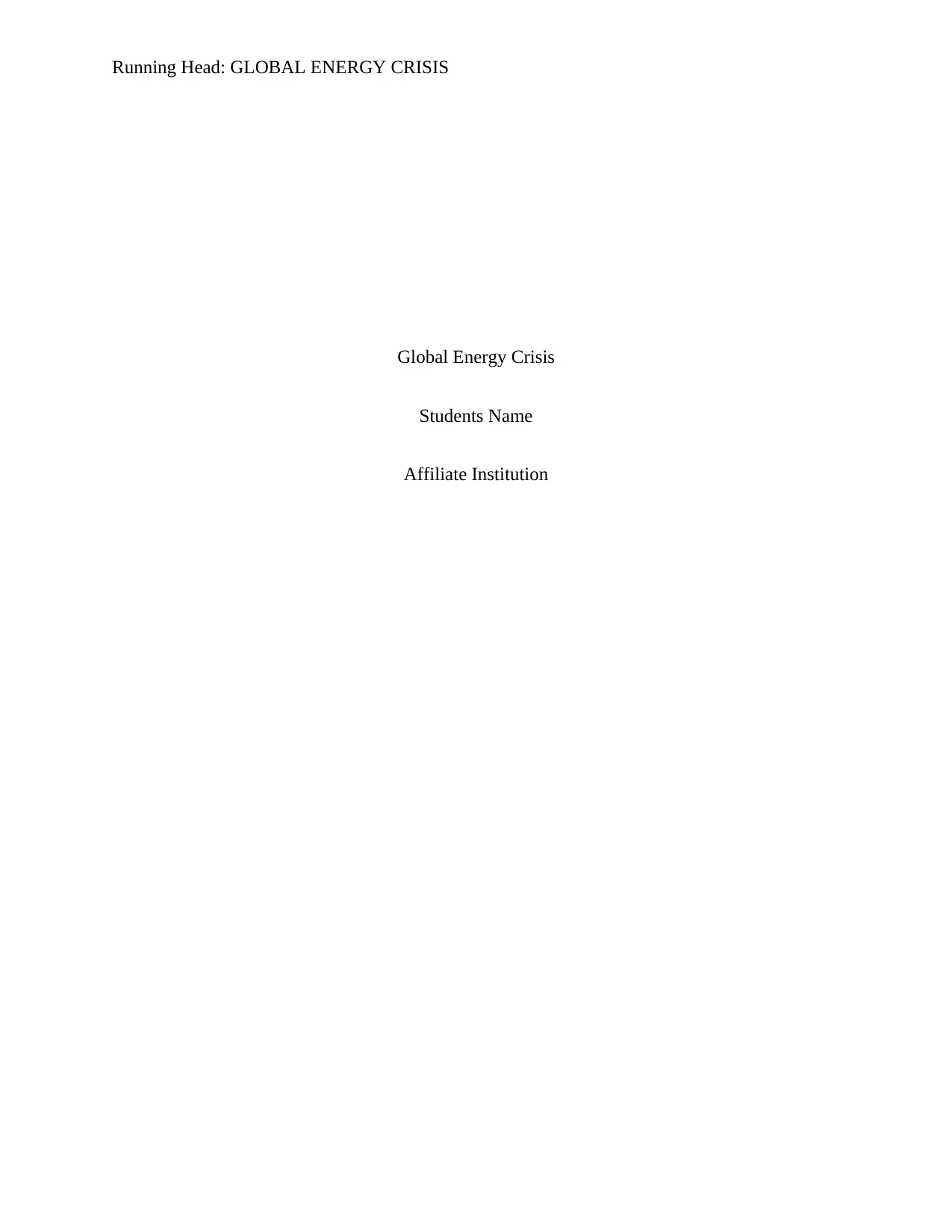
Running Head: GLOBAL ENERGY CRISIS
Global Energy Crisis
Students Name
Affiliate Institution
Global Energy Crisis
Students Name
Affiliate Institution
Paraphrase This Document
Need a fresh take? Get an instant paraphrase of this document with our AI Paraphraser
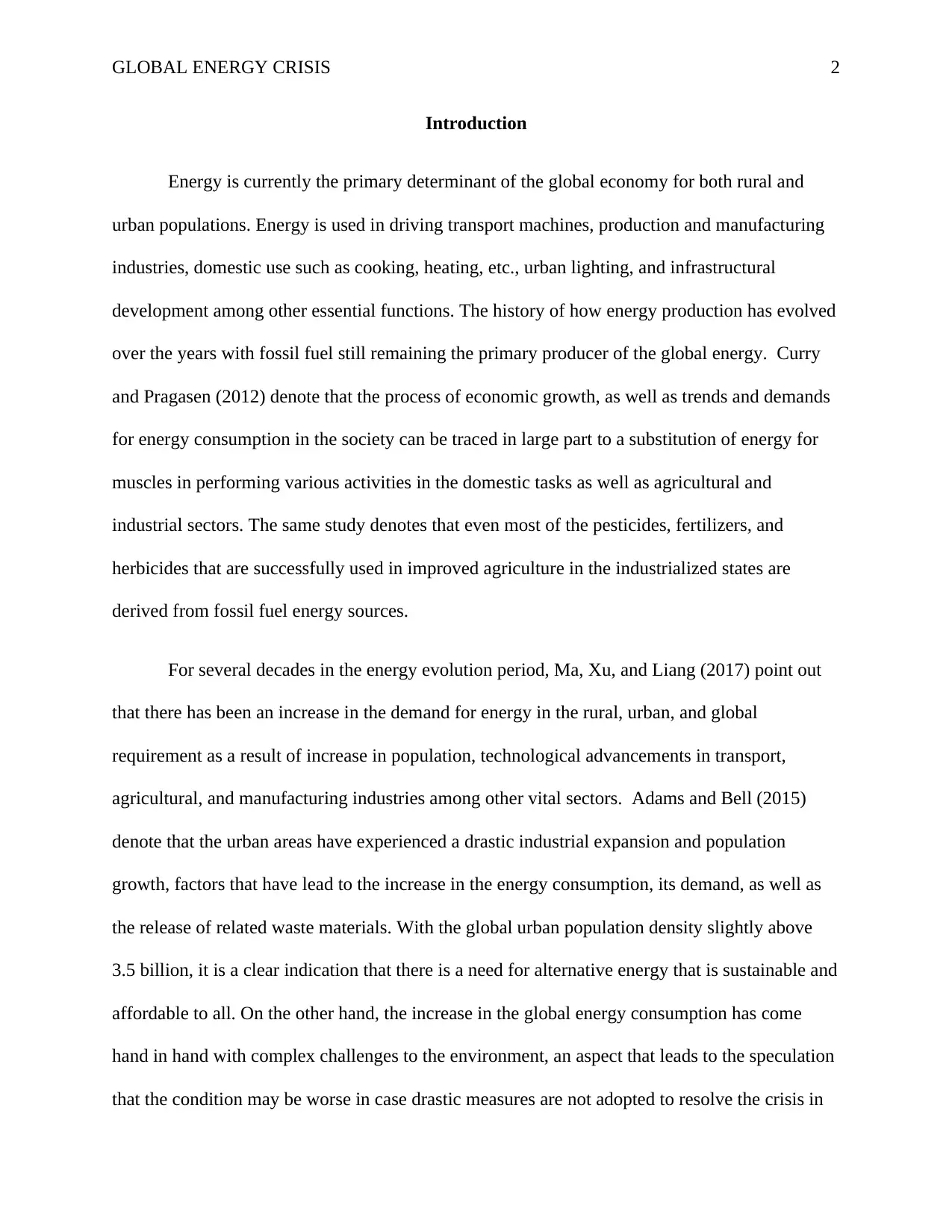
GLOBAL ENERGY CRISIS 2
Introduction
Energy is currently the primary determinant of the global economy for both rural and
urban populations. Energy is used in driving transport machines, production and manufacturing
industries, domestic use such as cooking, heating, etc., urban lighting, and infrastructural
development among other essential functions. The history of how energy production has evolved
over the years with fossil fuel still remaining the primary producer of the global energy. Curry
and Pragasen (2012) denote that the process of economic growth, as well as trends and demands
for energy consumption in the society can be traced in large part to a substitution of energy for
muscles in performing various activities in the domestic tasks as well as agricultural and
industrial sectors. The same study denotes that even most of the pesticides, fertilizers, and
herbicides that are successfully used in improved agriculture in the industrialized states are
derived from fossil fuel energy sources.
For several decades in the energy evolution period, Ma, Xu, and Liang (2017) point out
that there has been an increase in the demand for energy in the rural, urban, and global
requirement as a result of increase in population, technological advancements in transport,
agricultural, and manufacturing industries among other vital sectors. Adams and Bell (2015)
denote that the urban areas have experienced a drastic industrial expansion and population
growth, factors that have lead to the increase in the energy consumption, its demand, as well as
the release of related waste materials. With the global urban population density slightly above
3.5 billion, it is a clear indication that there is a need for alternative energy that is sustainable and
affordable to all. On the other hand, the increase in the global energy consumption has come
hand in hand with complex challenges to the environment, an aspect that leads to the speculation
that the condition may be worse in case drastic measures are not adopted to resolve the crisis in
Introduction
Energy is currently the primary determinant of the global economy for both rural and
urban populations. Energy is used in driving transport machines, production and manufacturing
industries, domestic use such as cooking, heating, etc., urban lighting, and infrastructural
development among other essential functions. The history of how energy production has evolved
over the years with fossil fuel still remaining the primary producer of the global energy. Curry
and Pragasen (2012) denote that the process of economic growth, as well as trends and demands
for energy consumption in the society can be traced in large part to a substitution of energy for
muscles in performing various activities in the domestic tasks as well as agricultural and
industrial sectors. The same study denotes that even most of the pesticides, fertilizers, and
herbicides that are successfully used in improved agriculture in the industrialized states are
derived from fossil fuel energy sources.
For several decades in the energy evolution period, Ma, Xu, and Liang (2017) point out
that there has been an increase in the demand for energy in the rural, urban, and global
requirement as a result of increase in population, technological advancements in transport,
agricultural, and manufacturing industries among other vital sectors. Adams and Bell (2015)
denote that the urban areas have experienced a drastic industrial expansion and population
growth, factors that have lead to the increase in the energy consumption, its demand, as well as
the release of related waste materials. With the global urban population density slightly above
3.5 billion, it is a clear indication that there is a need for alternative energy that is sustainable and
affordable to all. On the other hand, the increase in the global energy consumption has come
hand in hand with complex challenges to the environment, an aspect that leads to the speculation
that the condition may be worse in case drastic measures are not adopted to resolve the crisis in
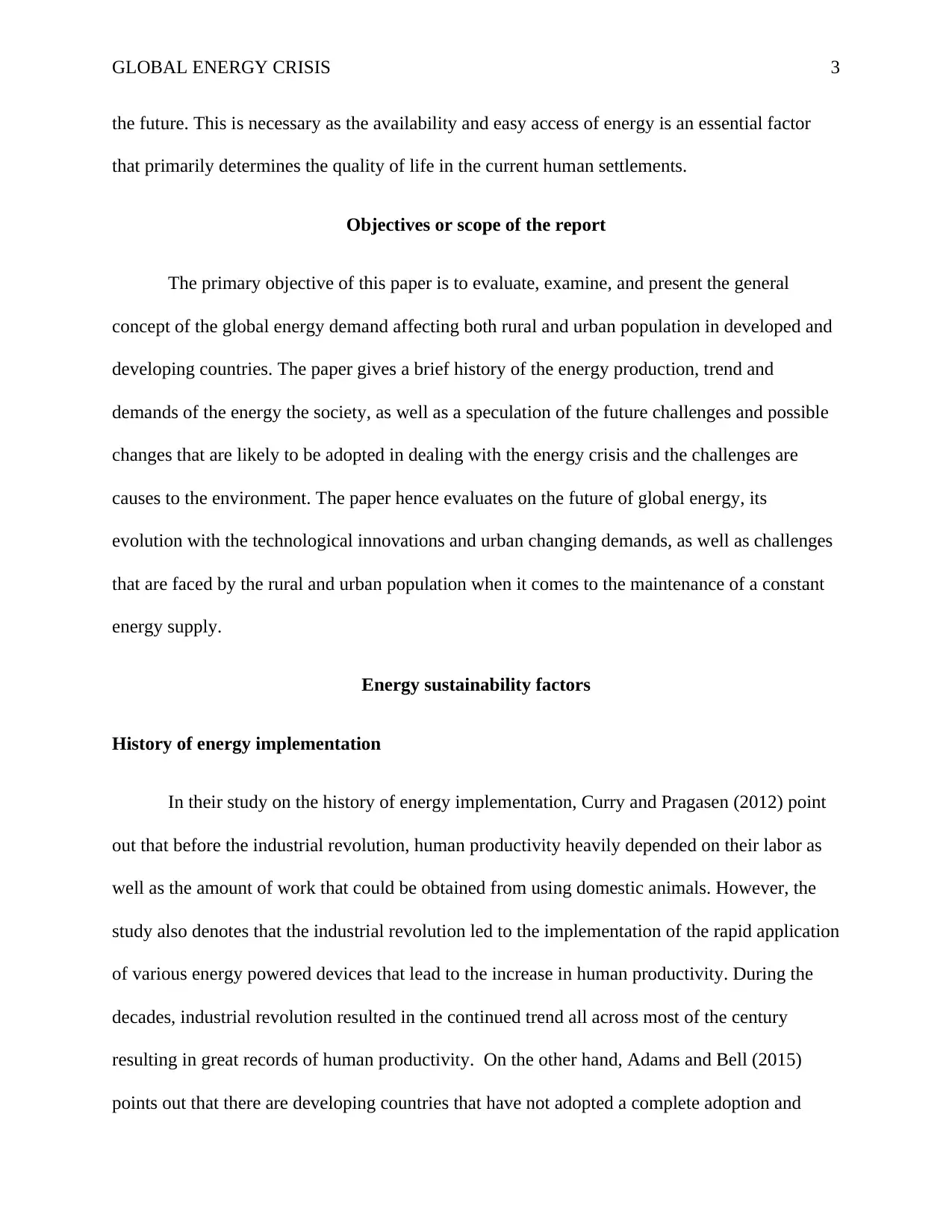
GLOBAL ENERGY CRISIS 3
the future. This is necessary as the availability and easy access of energy is an essential factor
that primarily determines the quality of life in the current human settlements.
Objectives or scope of the report
The primary objective of this paper is to evaluate, examine, and present the general
concept of the global energy demand affecting both rural and urban population in developed and
developing countries. The paper gives a brief history of the energy production, trend and
demands of the energy the society, as well as a speculation of the future challenges and possible
changes that are likely to be adopted in dealing with the energy crisis and the challenges are
causes to the environment. The paper hence evaluates on the future of global energy, its
evolution with the technological innovations and urban changing demands, as well as challenges
that are faced by the rural and urban population when it comes to the maintenance of a constant
energy supply.
Energy sustainability factors
History of energy implementation
In their study on the history of energy implementation, Curry and Pragasen (2012) point
out that before the industrial revolution, human productivity heavily depended on their labor as
well as the amount of work that could be obtained from using domestic animals. However, the
study also denotes that the industrial revolution led to the implementation of the rapid application
of various energy powered devices that lead to the increase in human productivity. During the
decades, industrial revolution resulted in the continued trend all across most of the century
resulting in great records of human productivity. On the other hand, Adams and Bell (2015)
points out that there are developing countries that have not adopted a complete adoption and
the future. This is necessary as the availability and easy access of energy is an essential factor
that primarily determines the quality of life in the current human settlements.
Objectives or scope of the report
The primary objective of this paper is to evaluate, examine, and present the general
concept of the global energy demand affecting both rural and urban population in developed and
developing countries. The paper gives a brief history of the energy production, trend and
demands of the energy the society, as well as a speculation of the future challenges and possible
changes that are likely to be adopted in dealing with the energy crisis and the challenges are
causes to the environment. The paper hence evaluates on the future of global energy, its
evolution with the technological innovations and urban changing demands, as well as challenges
that are faced by the rural and urban population when it comes to the maintenance of a constant
energy supply.
Energy sustainability factors
History of energy implementation
In their study on the history of energy implementation, Curry and Pragasen (2012) point
out that before the industrial revolution, human productivity heavily depended on their labor as
well as the amount of work that could be obtained from using domestic animals. However, the
study also denotes that the industrial revolution led to the implementation of the rapid application
of various energy powered devices that lead to the increase in human productivity. During the
decades, industrial revolution resulted in the continued trend all across most of the century
resulting in great records of human productivity. On the other hand, Adams and Bell (2015)
points out that there are developing countries that have not adopted a complete adoption and
⊘ This is a preview!⊘
Do you want full access?
Subscribe today to unlock all pages.

Trusted by 1+ million students worldwide
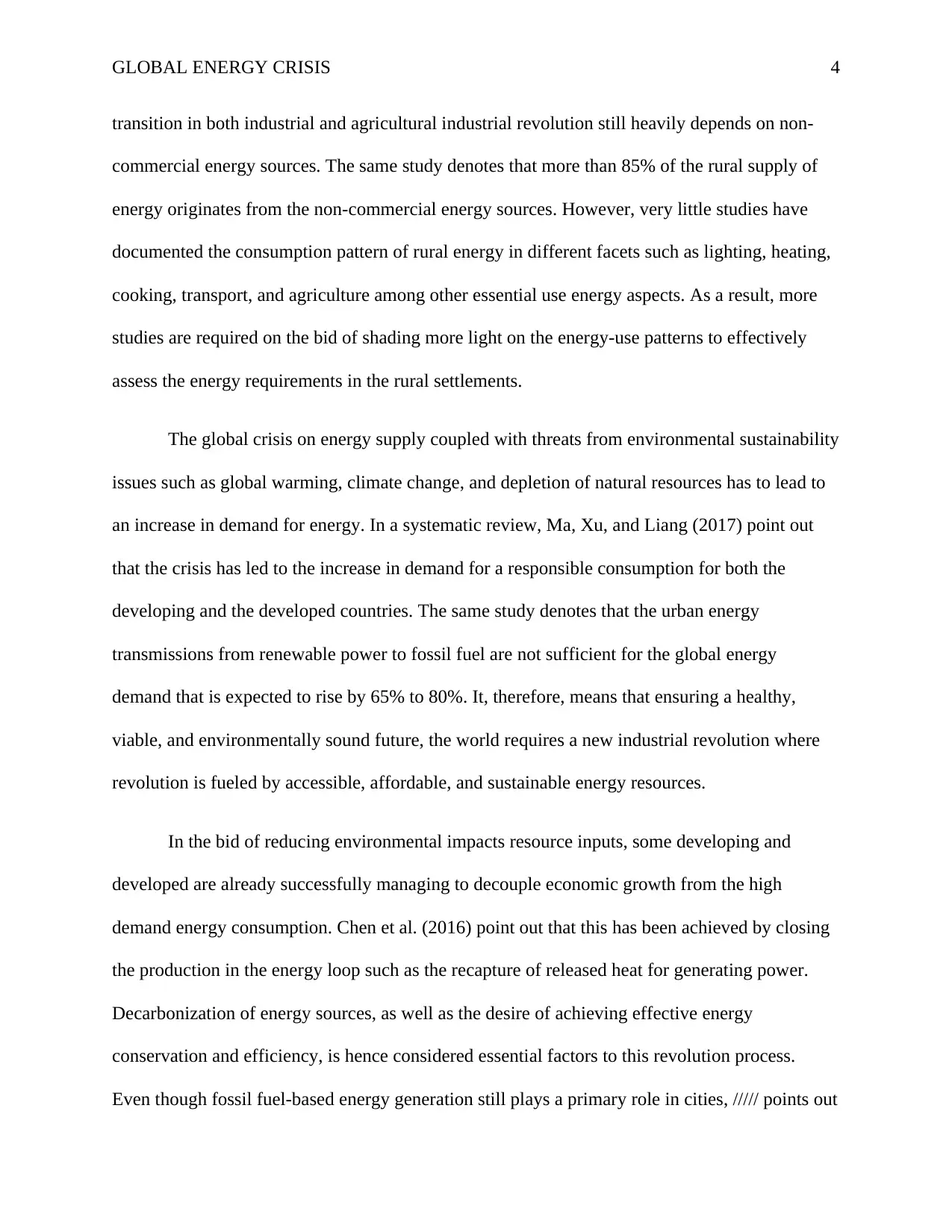
GLOBAL ENERGY CRISIS 4
transition in both industrial and agricultural industrial revolution still heavily depends on non-
commercial energy sources. The same study denotes that more than 85% of the rural supply of
energy originates from the non-commercial energy sources. However, very little studies have
documented the consumption pattern of rural energy in different facets such as lighting, heating,
cooking, transport, and agriculture among other essential use energy aspects. As a result, more
studies are required on the bid of shading more light on the energy-use patterns to effectively
assess the energy requirements in the rural settlements.
The global crisis on energy supply coupled with threats from environmental sustainability
issues such as global warming, climate change, and depletion of natural resources has to lead to
an increase in demand for energy. In a systematic review, Ma, Xu, and Liang (2017) point out
that the crisis has led to the increase in demand for a responsible consumption for both the
developing and the developed countries. The same study denotes that the urban energy
transmissions from renewable power to fossil fuel are not sufficient for the global energy
demand that is expected to rise by 65% to 80%. It, therefore, means that ensuring a healthy,
viable, and environmentally sound future, the world requires a new industrial revolution where
revolution is fueled by accessible, affordable, and sustainable energy resources.
In the bid of reducing environmental impacts resource inputs, some developing and
developed are already successfully managing to decouple economic growth from the high
demand energy consumption. Chen et al. (2016) point out that this has been achieved by closing
the production in the energy loop such as the recapture of released heat for generating power.
Decarbonization of energy sources, as well as the desire of achieving effective energy
conservation and efficiency, is hence considered essential factors to this revolution process.
Even though fossil fuel-based energy generation still plays a primary role in cities, ///// points out
transition in both industrial and agricultural industrial revolution still heavily depends on non-
commercial energy sources. The same study denotes that more than 85% of the rural supply of
energy originates from the non-commercial energy sources. However, very little studies have
documented the consumption pattern of rural energy in different facets such as lighting, heating,
cooking, transport, and agriculture among other essential use energy aspects. As a result, more
studies are required on the bid of shading more light on the energy-use patterns to effectively
assess the energy requirements in the rural settlements.
The global crisis on energy supply coupled with threats from environmental sustainability
issues such as global warming, climate change, and depletion of natural resources has to lead to
an increase in demand for energy. In a systematic review, Ma, Xu, and Liang (2017) point out
that the crisis has led to the increase in demand for a responsible consumption for both the
developing and the developed countries. The same study denotes that the urban energy
transmissions from renewable power to fossil fuel are not sufficient for the global energy
demand that is expected to rise by 65% to 80%. It, therefore, means that ensuring a healthy,
viable, and environmentally sound future, the world requires a new industrial revolution where
revolution is fueled by accessible, affordable, and sustainable energy resources.
In the bid of reducing environmental impacts resource inputs, some developing and
developed are already successfully managing to decouple economic growth from the high
demand energy consumption. Chen et al. (2016) point out that this has been achieved by closing
the production in the energy loop such as the recapture of released heat for generating power.
Decarbonization of energy sources, as well as the desire of achieving effective energy
conservation and efficiency, is hence considered essential factors to this revolution process.
Even though fossil fuel-based energy generation still plays a primary role in cities, ///// points out
Paraphrase This Document
Need a fresh take? Get an instant paraphrase of this document with our AI Paraphraser
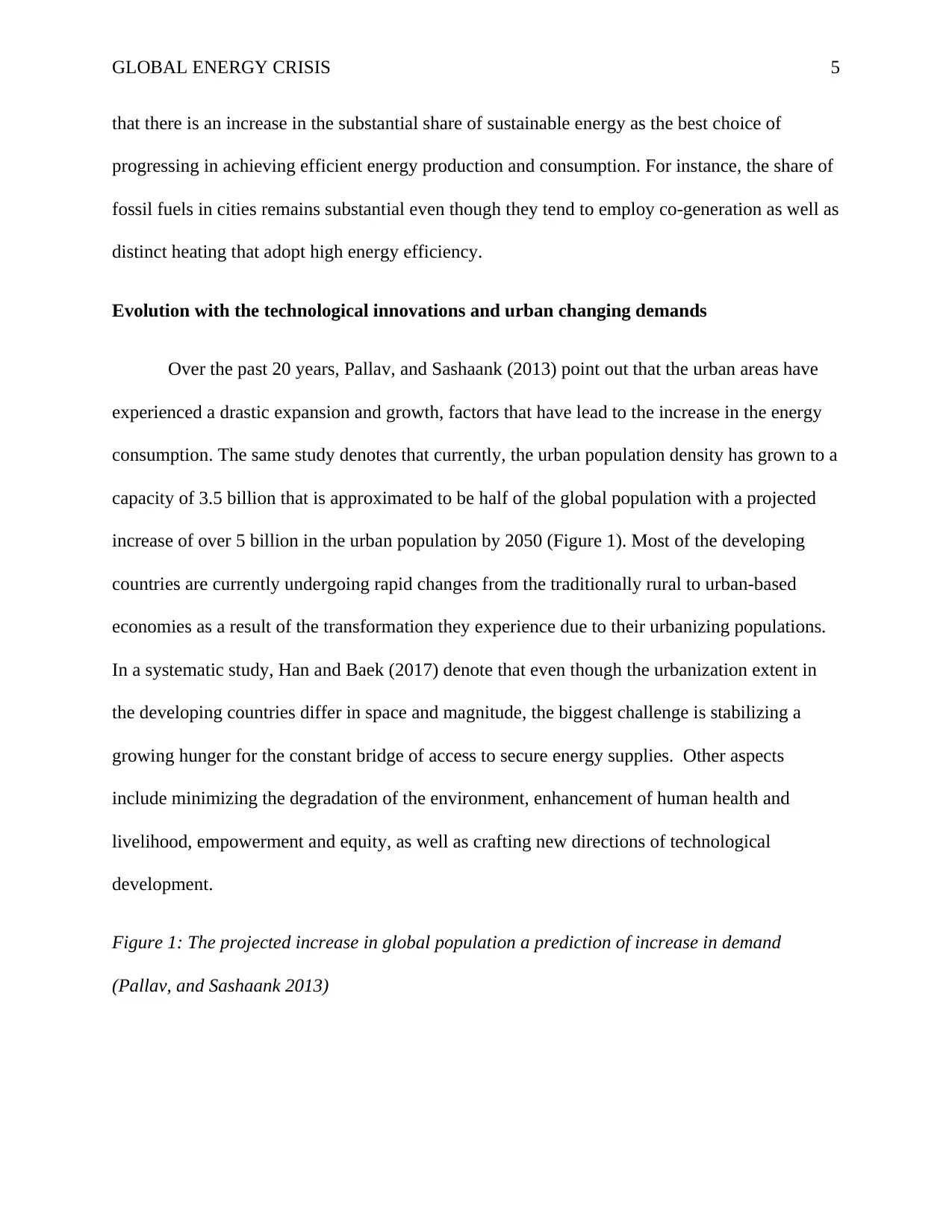
GLOBAL ENERGY CRISIS 5
that there is an increase in the substantial share of sustainable energy as the best choice of
progressing in achieving efficient energy production and consumption. For instance, the share of
fossil fuels in cities remains substantial even though they tend to employ co-generation as well as
distinct heating that adopt high energy efficiency.
Evolution with the technological innovations and urban changing demands
Over the past 20 years, Pallav, and Sashaank (2013) point out that the urban areas have
experienced a drastic expansion and growth, factors that have lead to the increase in the energy
consumption. The same study denotes that currently, the urban population density has grown to a
capacity of 3.5 billion that is approximated to be half of the global population with a projected
increase of over 5 billion in the urban population by 2050 (Figure 1). Most of the developing
countries are currently undergoing rapid changes from the traditionally rural to urban-based
economies as a result of the transformation they experience due to their urbanizing populations.
In a systematic study, Han and Baek (2017) denote that even though the urbanization extent in
the developing countries differ in space and magnitude, the biggest challenge is stabilizing a
growing hunger for the constant bridge of access to secure energy supplies. Other aspects
include minimizing the degradation of the environment, enhancement of human health and
livelihood, empowerment and equity, as well as crafting new directions of technological
development.
Figure 1: The projected increase in global population a prediction of increase in demand
(Pallav, and Sashaank 2013)
that there is an increase in the substantial share of sustainable energy as the best choice of
progressing in achieving efficient energy production and consumption. For instance, the share of
fossil fuels in cities remains substantial even though they tend to employ co-generation as well as
distinct heating that adopt high energy efficiency.
Evolution with the technological innovations and urban changing demands
Over the past 20 years, Pallav, and Sashaank (2013) point out that the urban areas have
experienced a drastic expansion and growth, factors that have lead to the increase in the energy
consumption. The same study denotes that currently, the urban population density has grown to a
capacity of 3.5 billion that is approximated to be half of the global population with a projected
increase of over 5 billion in the urban population by 2050 (Figure 1). Most of the developing
countries are currently undergoing rapid changes from the traditionally rural to urban-based
economies as a result of the transformation they experience due to their urbanizing populations.
In a systematic study, Han and Baek (2017) denote that even though the urbanization extent in
the developing countries differ in space and magnitude, the biggest challenge is stabilizing a
growing hunger for the constant bridge of access to secure energy supplies. Other aspects
include minimizing the degradation of the environment, enhancement of human health and
livelihood, empowerment and equity, as well as crafting new directions of technological
development.
Figure 1: The projected increase in global population a prediction of increase in demand
(Pallav, and Sashaank 2013)
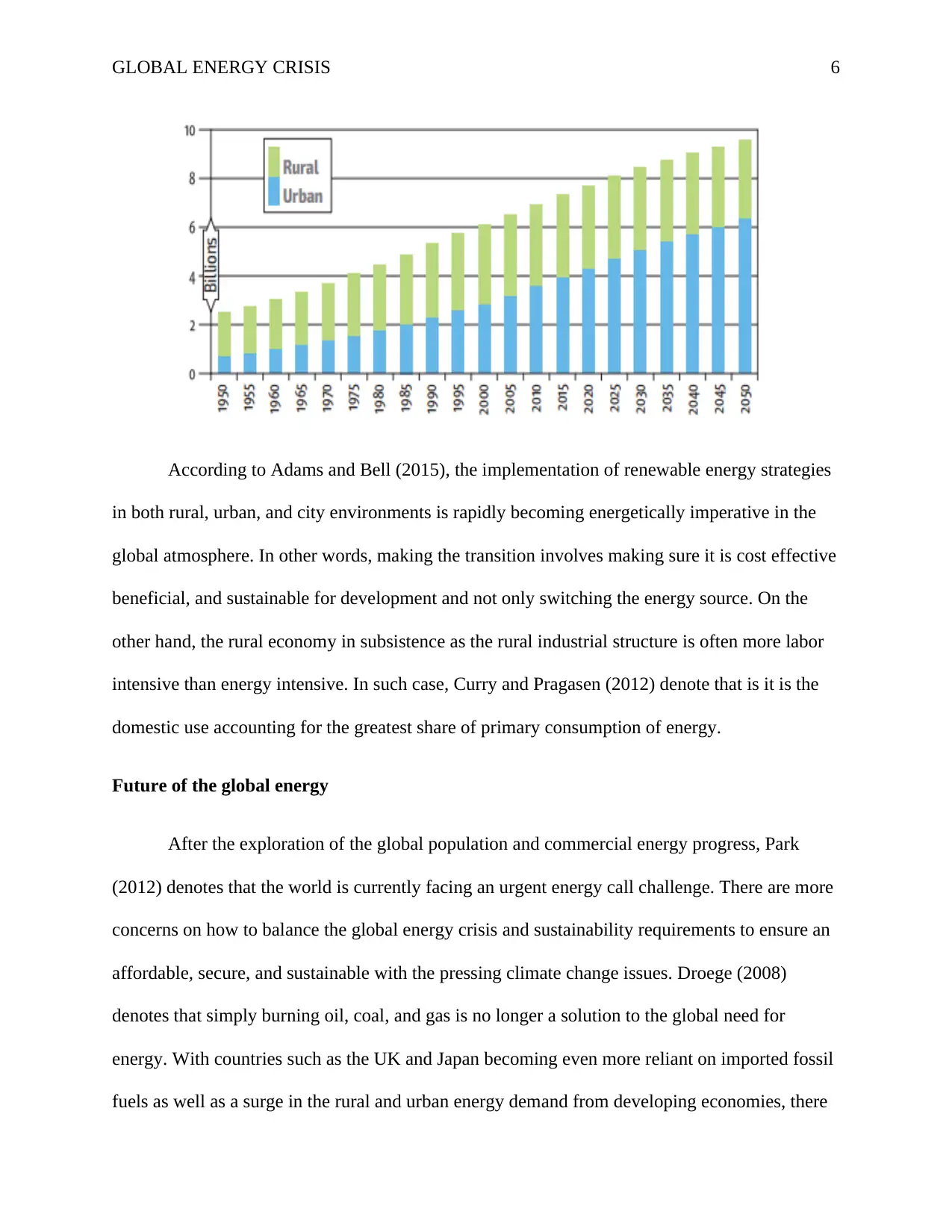
GLOBAL ENERGY CRISIS 6
According to Adams and Bell (2015), the implementation of renewable energy strategies
in both rural, urban, and city environments is rapidly becoming energetically imperative in the
global atmosphere. In other words, making the transition involves making sure it is cost effective
beneficial, and sustainable for development and not only switching the energy source. On the
other hand, the rural economy in subsistence as the rural industrial structure is often more labor
intensive than energy intensive. In such case, Curry and Pragasen (2012) denote that is it is the
domestic use accounting for the greatest share of primary consumption of energy.
Future of the global energy
After the exploration of the global population and commercial energy progress, Park
(2012) denotes that the world is currently facing an urgent energy call challenge. There are more
concerns on how to balance the global energy crisis and sustainability requirements to ensure an
affordable, secure, and sustainable with the pressing climate change issues. Droege (2008)
denotes that simply burning oil, coal, and gas is no longer a solution to the global need for
energy. With countries such as the UK and Japan becoming even more reliant on imported fossil
fuels as well as a surge in the rural and urban energy demand from developing economies, there
According to Adams and Bell (2015), the implementation of renewable energy strategies
in both rural, urban, and city environments is rapidly becoming energetically imperative in the
global atmosphere. In other words, making the transition involves making sure it is cost effective
beneficial, and sustainable for development and not only switching the energy source. On the
other hand, the rural economy in subsistence as the rural industrial structure is often more labor
intensive than energy intensive. In such case, Curry and Pragasen (2012) denote that is it is the
domestic use accounting for the greatest share of primary consumption of energy.
Future of the global energy
After the exploration of the global population and commercial energy progress, Park
(2012) denotes that the world is currently facing an urgent energy call challenge. There are more
concerns on how to balance the global energy crisis and sustainability requirements to ensure an
affordable, secure, and sustainable with the pressing climate change issues. Droege (2008)
denotes that simply burning oil, coal, and gas is no longer a solution to the global need for
energy. With countries such as the UK and Japan becoming even more reliant on imported fossil
fuels as well as a surge in the rural and urban energy demand from developing economies, there
⊘ This is a preview!⊘
Do you want full access?
Subscribe today to unlock all pages.

Trusted by 1+ million students worldwide
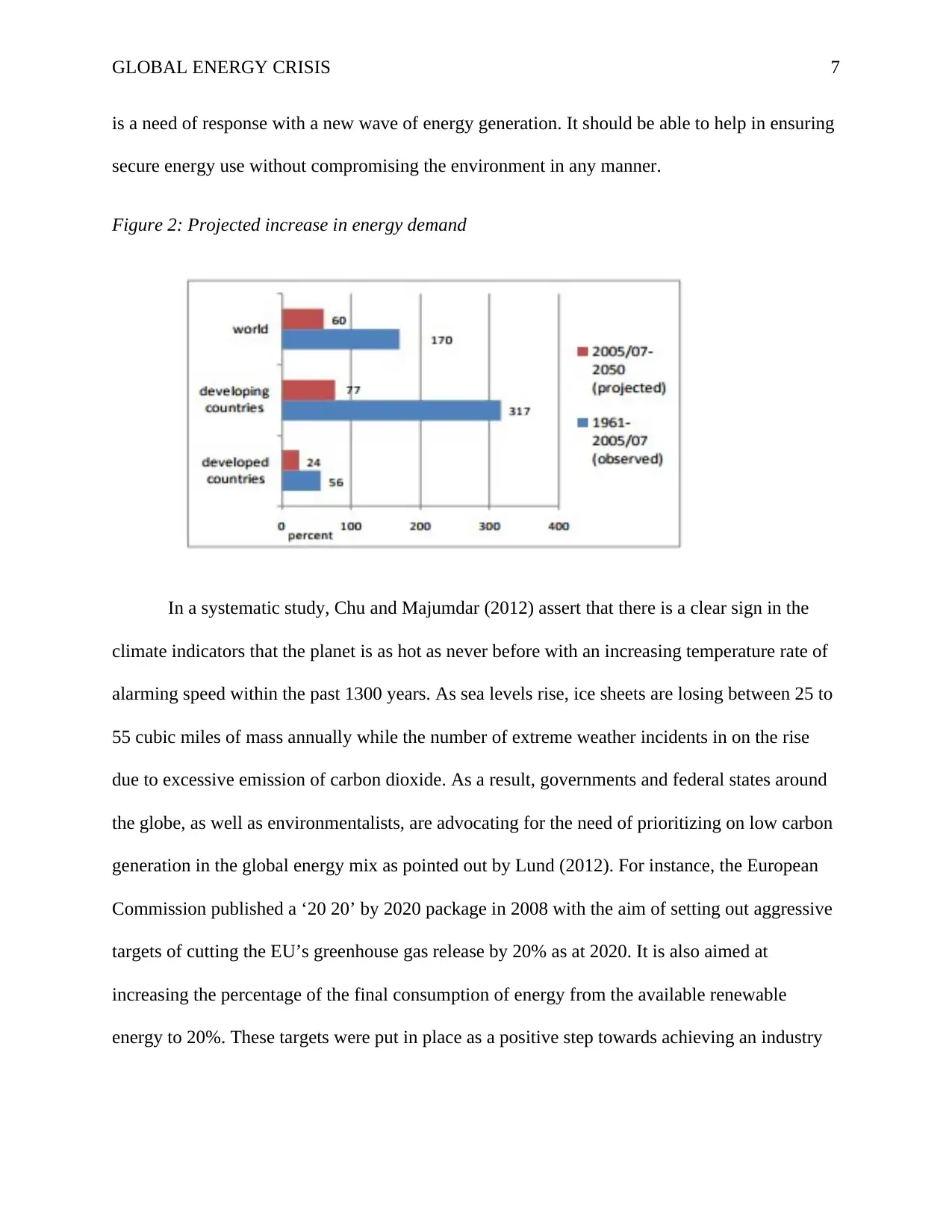
GLOBAL ENERGY CRISIS 7
is a need of response with a new wave of energy generation. It should be able to help in ensuring
secure energy use without compromising the environment in any manner.
Figure 2: Projected increase in energy demand
In a systematic study, Chu and Majumdar (2012) assert that there is a clear sign in the
climate indicators that the planet is as hot as never before with an increasing temperature rate of
alarming speed within the past 1300 years. As sea levels rise, ice sheets are losing between 25 to
55 cubic miles of mass annually while the number of extreme weather incidents in on the rise
due to excessive emission of carbon dioxide. As a result, governments and federal states around
the globe, as well as environmentalists, are advocating for the need of prioritizing on low carbon
generation in the global energy mix as pointed out by Lund (2012). For instance, the European
Commission published a ‘20 20’ by 2020 package in 2008 with the aim of setting out aggressive
targets of cutting the EU’s greenhouse gas release by 20% as at 2020. It is also aimed at
increasing the percentage of the final consumption of energy from the available renewable
energy to 20%. These targets were put in place as a positive step towards achieving an industry
is a need of response with a new wave of energy generation. It should be able to help in ensuring
secure energy use without compromising the environment in any manner.
Figure 2: Projected increase in energy demand
In a systematic study, Chu and Majumdar (2012) assert that there is a clear sign in the
climate indicators that the planet is as hot as never before with an increasing temperature rate of
alarming speed within the past 1300 years. As sea levels rise, ice sheets are losing between 25 to
55 cubic miles of mass annually while the number of extreme weather incidents in on the rise
due to excessive emission of carbon dioxide. As a result, governments and federal states around
the globe, as well as environmentalists, are advocating for the need of prioritizing on low carbon
generation in the global energy mix as pointed out by Lund (2012). For instance, the European
Commission published a ‘20 20’ by 2020 package in 2008 with the aim of setting out aggressive
targets of cutting the EU’s greenhouse gas release by 20% as at 2020. It is also aimed at
increasing the percentage of the final consumption of energy from the available renewable
energy to 20%. These targets were put in place as a positive step towards achieving an industry
Paraphrase This Document
Need a fresh take? Get an instant paraphrase of this document with our AI Paraphraser
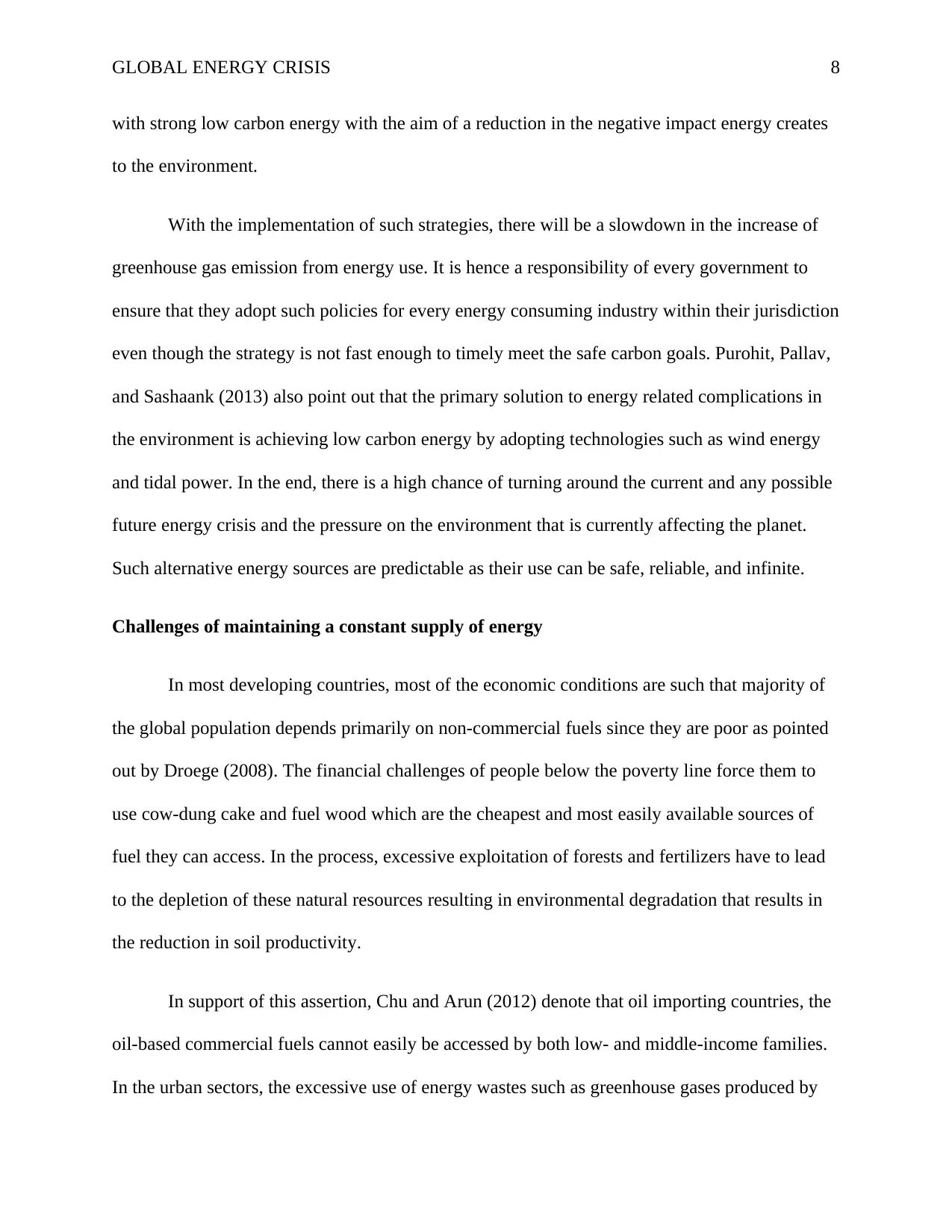
GLOBAL ENERGY CRISIS 8
with strong low carbon energy with the aim of a reduction in the negative impact energy creates
to the environment.
With the implementation of such strategies, there will be a slowdown in the increase of
greenhouse gas emission from energy use. It is hence a responsibility of every government to
ensure that they adopt such policies for every energy consuming industry within their jurisdiction
even though the strategy is not fast enough to timely meet the safe carbon goals. Purohit, Pallav,
and Sashaank (2013) also point out that the primary solution to energy related complications in
the environment is achieving low carbon energy by adopting technologies such as wind energy
and tidal power. In the end, there is a high chance of turning around the current and any possible
future energy crisis and the pressure on the environment that is currently affecting the planet.
Such alternative energy sources are predictable as their use can be safe, reliable, and infinite.
Challenges of maintaining a constant supply of energy
In most developing countries, most of the economic conditions are such that majority of
the global population depends primarily on non-commercial fuels since they are poor as pointed
out by Droege (2008). The financial challenges of people below the poverty line force them to
use cow-dung cake and fuel wood which are the cheapest and most easily available sources of
fuel they can access. In the process, excessive exploitation of forests and fertilizers have to lead
to the depletion of these natural resources resulting in environmental degradation that results in
the reduction in soil productivity.
In support of this assertion, Chu and Arun (2012) denote that oil importing countries, the
oil-based commercial fuels cannot easily be accessed by both low- and middle-income families.
In the urban sectors, the excessive use of energy wastes such as greenhouse gases produced by
with strong low carbon energy with the aim of a reduction in the negative impact energy creates
to the environment.
With the implementation of such strategies, there will be a slowdown in the increase of
greenhouse gas emission from energy use. It is hence a responsibility of every government to
ensure that they adopt such policies for every energy consuming industry within their jurisdiction
even though the strategy is not fast enough to timely meet the safe carbon goals. Purohit, Pallav,
and Sashaank (2013) also point out that the primary solution to energy related complications in
the environment is achieving low carbon energy by adopting technologies such as wind energy
and tidal power. In the end, there is a high chance of turning around the current and any possible
future energy crisis and the pressure on the environment that is currently affecting the planet.
Such alternative energy sources are predictable as their use can be safe, reliable, and infinite.
Challenges of maintaining a constant supply of energy
In most developing countries, most of the economic conditions are such that majority of
the global population depends primarily on non-commercial fuels since they are poor as pointed
out by Droege (2008). The financial challenges of people below the poverty line force them to
use cow-dung cake and fuel wood which are the cheapest and most easily available sources of
fuel they can access. In the process, excessive exploitation of forests and fertilizers have to lead
to the depletion of these natural resources resulting in environmental degradation that results in
the reduction in soil productivity.
In support of this assertion, Chu and Arun (2012) denote that oil importing countries, the
oil-based commercial fuels cannot easily be accessed by both low- and middle-income families.
In the urban sectors, the excessive use of energy wastes such as greenhouse gases produced by
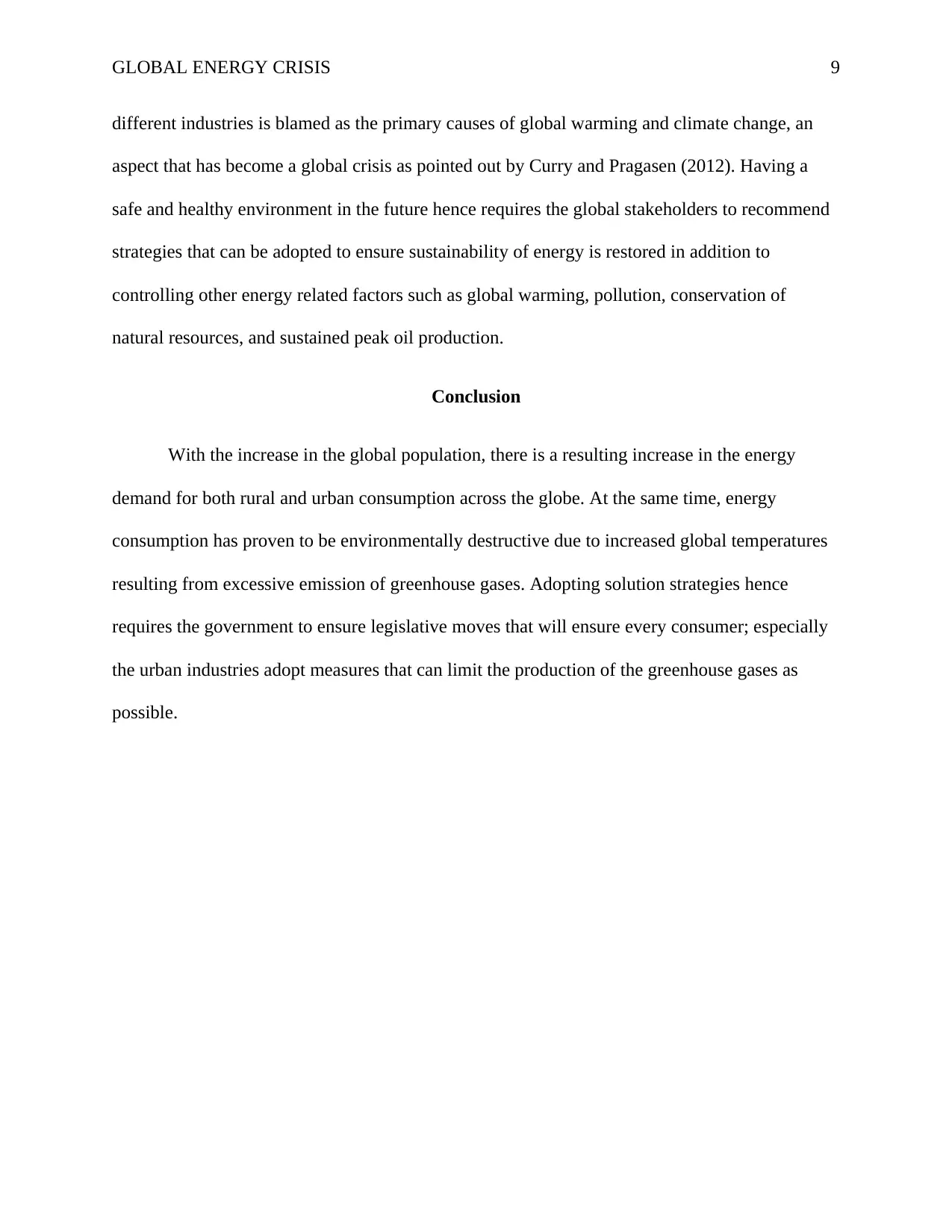
GLOBAL ENERGY CRISIS 9
different industries is blamed as the primary causes of global warming and climate change, an
aspect that has become a global crisis as pointed out by Curry and Pragasen (2012). Having a
safe and healthy environment in the future hence requires the global stakeholders to recommend
strategies that can be adopted to ensure sustainability of energy is restored in addition to
controlling other energy related factors such as global warming, pollution, conservation of
natural resources, and sustained peak oil production.
Conclusion
With the increase in the global population, there is a resulting increase in the energy
demand for both rural and urban consumption across the globe. At the same time, energy
consumption has proven to be environmentally destructive due to increased global temperatures
resulting from excessive emission of greenhouse gases. Adopting solution strategies hence
requires the government to ensure legislative moves that will ensure every consumer; especially
the urban industries adopt measures that can limit the production of the greenhouse gases as
possible.
different industries is blamed as the primary causes of global warming and climate change, an
aspect that has become a global crisis as pointed out by Curry and Pragasen (2012). Having a
safe and healthy environment in the future hence requires the global stakeholders to recommend
strategies that can be adopted to ensure sustainability of energy is restored in addition to
controlling other energy related factors such as global warming, pollution, conservation of
natural resources, and sustained peak oil production.
Conclusion
With the increase in the global population, there is a resulting increase in the energy
demand for both rural and urban consumption across the globe. At the same time, energy
consumption has proven to be environmentally destructive due to increased global temperatures
resulting from excessive emission of greenhouse gases. Adopting solution strategies hence
requires the government to ensure legislative moves that will ensure every consumer; especially
the urban industries adopt measures that can limit the production of the greenhouse gases as
possible.
⊘ This is a preview!⊘
Do you want full access?
Subscribe today to unlock all pages.

Trusted by 1+ million students worldwide
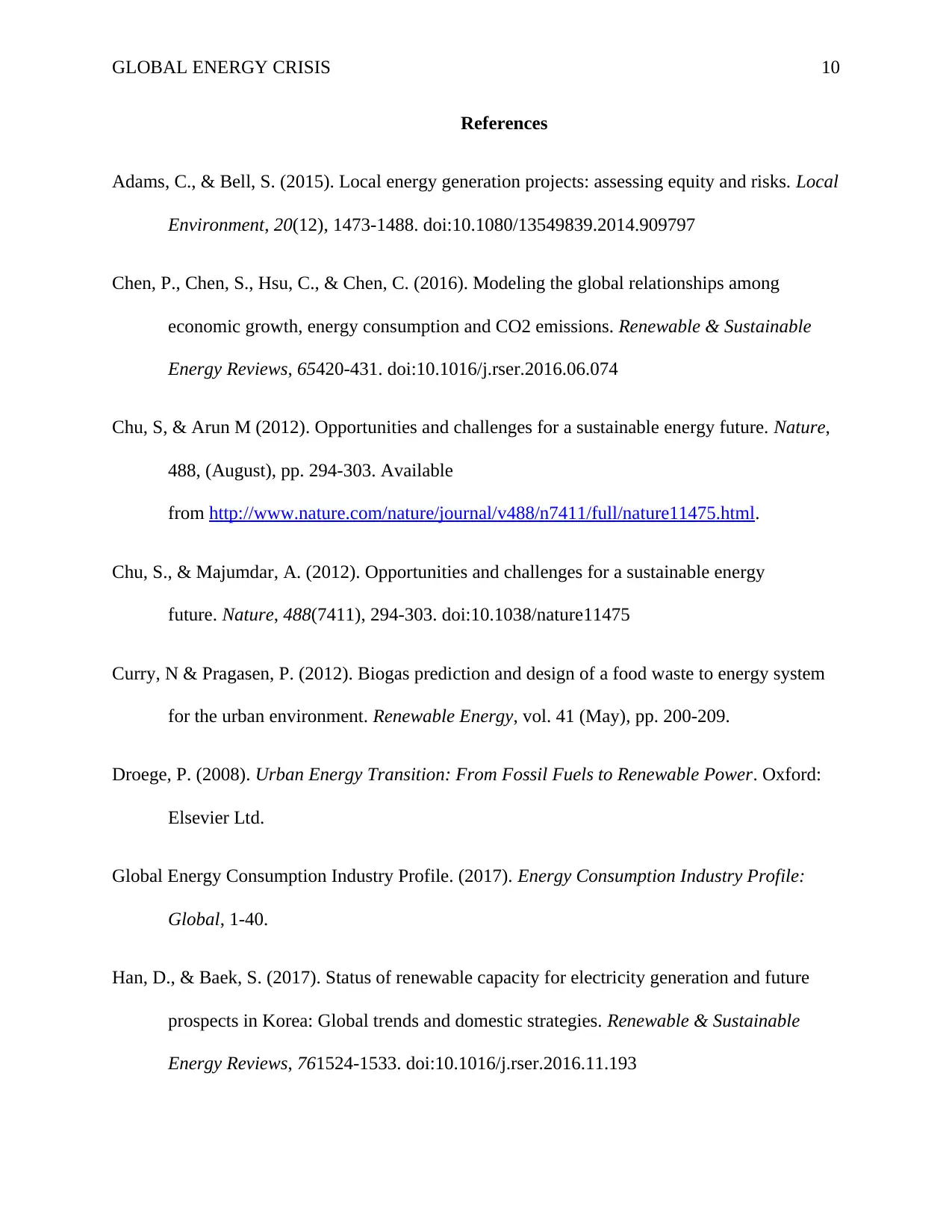
GLOBAL ENERGY CRISIS 10
References
Adams, C., & Bell, S. (2015). Local energy generation projects: assessing equity and risks. Local
Environment, 20(12), 1473-1488. doi:10.1080/13549839.2014.909797
Chen, P., Chen, S., Hsu, C., & Chen, C. (2016). Modeling the global relationships among
economic growth, energy consumption and CO2 emissions. Renewable & Sustainable
Energy Reviews, 65420-431. doi:10.1016/j.rser.2016.06.074
Chu, S, & Arun M (2012). Opportunities and challenges for a sustainable energy future. Nature,
488, (August), pp. 294-303. Available
from http://www.nature.com/nature/journal/v488/n7411/full/nature11475.html.
Chu, S., & Majumdar, A. (2012). Opportunities and challenges for a sustainable energy
future. Nature, 488(7411), 294-303. doi:10.1038/nature11475
Curry, N & Pragasen, P. (2012). Biogas prediction and design of a food waste to energy system
for the urban environment. Renewable Energy, vol. 41 (May), pp. 200-209.
Droege, P. (2008). Urban Energy Transition: From Fossil Fuels to Renewable Power. Oxford:
Elsevier Ltd.
Global Energy Consumption Industry Profile. (2017). Energy Consumption Industry Profile:
Global, 1-40.
Han, D., & Baek, S. (2017). Status of renewable capacity for electricity generation and future
prospects in Korea: Global trends and domestic strategies. Renewable & Sustainable
Energy Reviews, 761524-1533. doi:10.1016/j.rser.2016.11.193
References
Adams, C., & Bell, S. (2015). Local energy generation projects: assessing equity and risks. Local
Environment, 20(12), 1473-1488. doi:10.1080/13549839.2014.909797
Chen, P., Chen, S., Hsu, C., & Chen, C. (2016). Modeling the global relationships among
economic growth, energy consumption and CO2 emissions. Renewable & Sustainable
Energy Reviews, 65420-431. doi:10.1016/j.rser.2016.06.074
Chu, S, & Arun M (2012). Opportunities and challenges for a sustainable energy future. Nature,
488, (August), pp. 294-303. Available
from http://www.nature.com/nature/journal/v488/n7411/full/nature11475.html.
Chu, S., & Majumdar, A. (2012). Opportunities and challenges for a sustainable energy
future. Nature, 488(7411), 294-303. doi:10.1038/nature11475
Curry, N & Pragasen, P. (2012). Biogas prediction and design of a food waste to energy system
for the urban environment. Renewable Energy, vol. 41 (May), pp. 200-209.
Droege, P. (2008). Urban Energy Transition: From Fossil Fuels to Renewable Power. Oxford:
Elsevier Ltd.
Global Energy Consumption Industry Profile. (2017). Energy Consumption Industry Profile:
Global, 1-40.
Han, D., & Baek, S. (2017). Status of renewable capacity for electricity generation and future
prospects in Korea: Global trends and domestic strategies. Renewable & Sustainable
Energy Reviews, 761524-1533. doi:10.1016/j.rser.2016.11.193
Paraphrase This Document
Need a fresh take? Get an instant paraphrase of this document with our AI Paraphraser
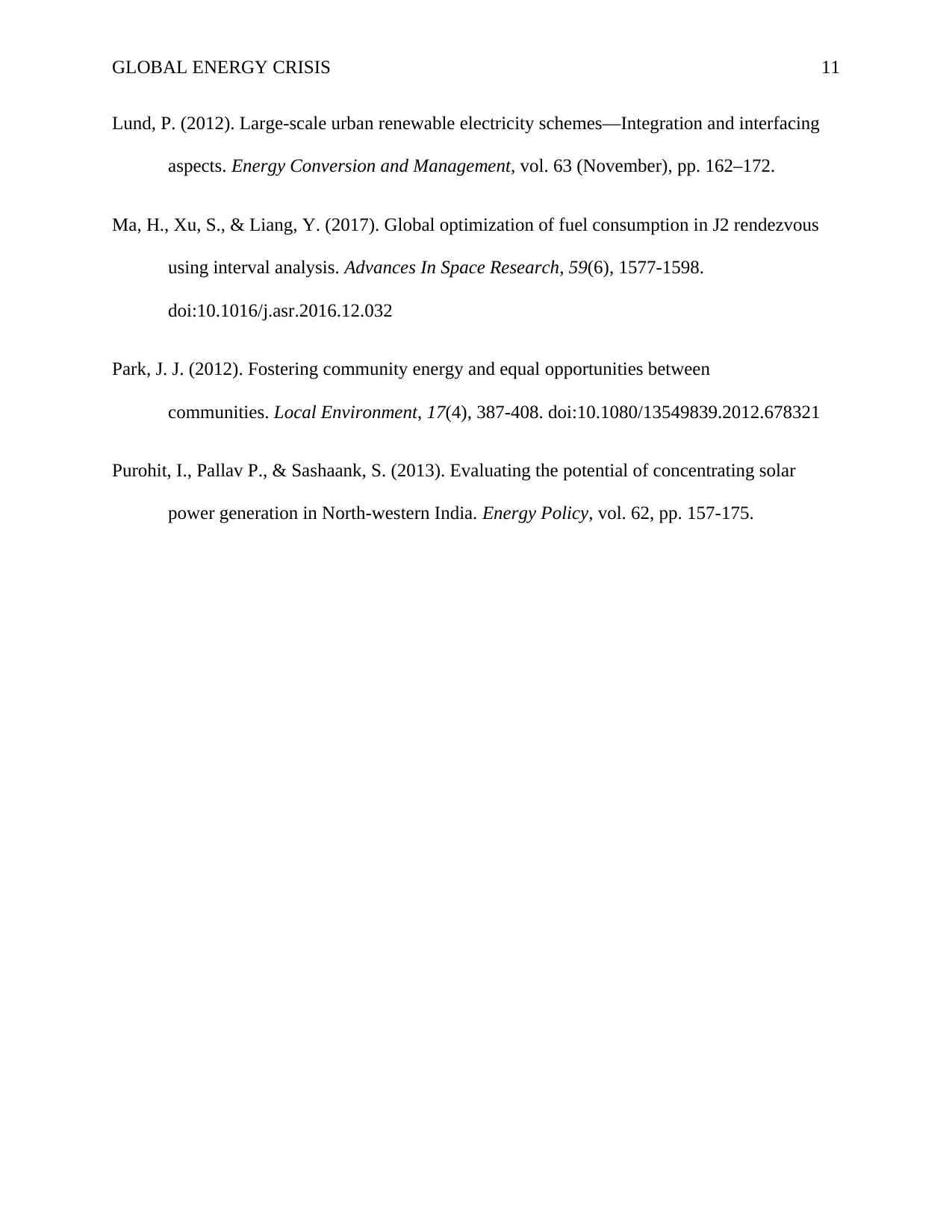
GLOBAL ENERGY CRISIS 11
Lund, P. (2012). Large-scale urban renewable electricity schemes—Integration and interfacing
aspects. Energy Conversion and Management, vol. 63 (November), pp. 162–172.
Ma, H., Xu, S., & Liang, Y. (2017). Global optimization of fuel consumption in J2 rendezvous
using interval analysis. Advances In Space Research, 59(6), 1577-1598.
doi:10.1016/j.asr.2016.12.032
Park, J. J. (2012). Fostering community energy and equal opportunities between
communities. Local Environment, 17(4), 387-408. doi:10.1080/13549839.2012.678321
Purohit, I., Pallav P., & Sashaank, S. (2013). Evaluating the potential of concentrating solar
power generation in North-western India. Energy Policy, vol. 62, pp. 157-175.
Lund, P. (2012). Large-scale urban renewable electricity schemes—Integration and interfacing
aspects. Energy Conversion and Management, vol. 63 (November), pp. 162–172.
Ma, H., Xu, S., & Liang, Y. (2017). Global optimization of fuel consumption in J2 rendezvous
using interval analysis. Advances In Space Research, 59(6), 1577-1598.
doi:10.1016/j.asr.2016.12.032
Park, J. J. (2012). Fostering community energy and equal opportunities between
communities. Local Environment, 17(4), 387-408. doi:10.1080/13549839.2012.678321
Purohit, I., Pallav P., & Sashaank, S. (2013). Evaluating the potential of concentrating solar
power generation in North-western India. Energy Policy, vol. 62, pp. 157-175.
1 out of 11
Related Documents
Your All-in-One AI-Powered Toolkit for Academic Success.
+13062052269
info@desklib.com
Available 24*7 on WhatsApp / Email
![[object Object]](/_next/static/media/star-bottom.7253800d.svg)
Unlock your academic potential
Copyright © 2020–2025 A2Z Services. All Rights Reserved. Developed and managed by ZUCOL.




